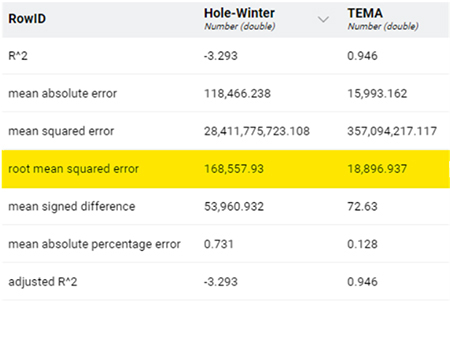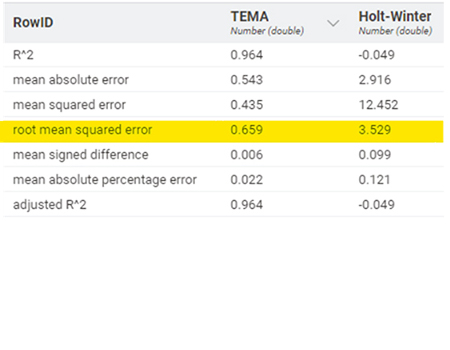Introduction
In time series forecasting, two Triple Exponential Smoothing methods are used widely Triple Exponential Smoothing Average (TEMA) and Holt-Winter’s utilize different methods to smooth out the values and enable accurate forecasting. However, these key differences between the two methods have an impact in the final forecast. TEMA is a simpler method that uses three weighted averages to smooth the data, whereas Holt-Winters is a more complex method that takes into account both trend and seasonality.Holt-winters Triple Exponential Smoothing
Holt-Winters method extends the concept in double exponential smoothing to account for three attributes Trend, Level and Seasonality of the data. It employs three smoothing factors, one for the level (α – alpha) , one for the trend (β – beta) and one for seasonality (Ɣ -gamma). All three areFormulae :
- Level (Lt) Lt = α * (Yt – St-m) + (1 – α) * (Lt-1 + Tt-1)
- Trend (Tt): Tt = β * (Lt – Lt-1) + (1 – β) * Tt-1
- Seasonality (St): St = Ɣ * (Yt – Lt) + (1 – Ɣ) * St-m
- Forecasting: Forecast for time t + h (Ft+h) = (Lt + Tt )* St-m
Triple Exponential Moving Average
Triple Exponential Moving Average (TEMA) extends the standard Single Exponential Smoothing by applying the Exponential Moving Average (EMA) values thrice. Three levels of EMA applied on the data set provides better smoothened and accurate forecasts.
Formula
- TEMA = 3 * EMA(α, price) – 3 * EMA(β, EMA(α, price)) + EMA(Ɣ,EMA(β, EMA(α, price)))
Refer detailed Double Exponential Smoothing Average blog “https://wisdomschema.com/blog/comparison-of-dema-holt-winter-double-exponential-smoothing/”
Dataset Information
Two different datasets were used to illustrate the differences between two methods
- Industry dataset : Erratic Trend
The sample dataset from the Industry schema is as follows, with a focus on the “salesorderheader” relation.
Field | Type | Candidate Variable |
|---|---|---|
| OrderID | Character | |
| CustomerID | Integer | |
| ShipDate | Timestamp | ✔ |
| SalespersonemployeeID | Integer | |
| ShipMethodID | Integer | |
| TerritoryID | Integer | |
| SubTotal | Numeric | ✔ |
Number of records : 1561
Candidate keys | Number of unique values | Max Value | Min Value |
|---|---|---|---|
| Subtotal | 623 | 129,261.254 | 2.29 |
| ShipDate | 675 | 2014-05-01 | 2011-06-01 |
2.Weather dataset : Visible Trend
Field | Type | Candidate Variable |
|---|---|---|
| Date | Timestamp | ✔ |
| temperature | numeric | ✔ |
| idx | Integer | ✔ |
Number of records : 216
Candidate keys | Number of unique values | Min Value | Max Value |
|---|---|---|---|
| temperature | 195 | 18.25 | 32.19 |
| ShipDate | 216 | 2000-01-01 | 2017-12-01 |
Workflow
Reading & Manipulating Data
- Industry
- The data is read via DB connector node and fed into KNIME via DB reader after choosing appropriate relation and extracting the necessary primary candidate key.
- SubTotal (i.e. measure) values are grouped by applying an aggregate function (SUM), and this grouping is based on month and year.
- Weather
- The data is stored in an excel and the data is read via the Excel reader node and fed into the KNIME
Forecasting
- Industry
- Execute the Triple exponential smoothing methodology on the data present in the “SubTotal” column using a standard node called “moving average”.
- Entire calculation for Holt-Winter method is performed using SQL delegated to backed in database by executing a database procedure using “DB Query Executer”
- Weather
- TEMA is calculated with the help of “moving average” node and the window size is chosen accordingly
- The Holt-Winters method was implemented in Excel, and the results were imported into KNIME for further processing.
Visualization
Forecast Accuracy
Summary
- TEMA is ideal for datasets where patterns are driven mainly by the trend, and there are no significant seasonal variations.
- It is efficient when dealing with data without repeating cycles or where seasonal effects
- Holt-Winters tends to provide more accurate forecasts when the historical data shows consistent seasonal patterns.
- By considering both trend and seasonality, it can model and predict future values in a way that reflects the underlying patterns in the data.
- If the data lacks seasonal patterns, TEMA might yield simpler and accurate results. On the other hand, if seasonality is evident, Holt-Winters is the preferred choice for reliable forecasts.
Authors
- VedhashreeU
- Kaptain






